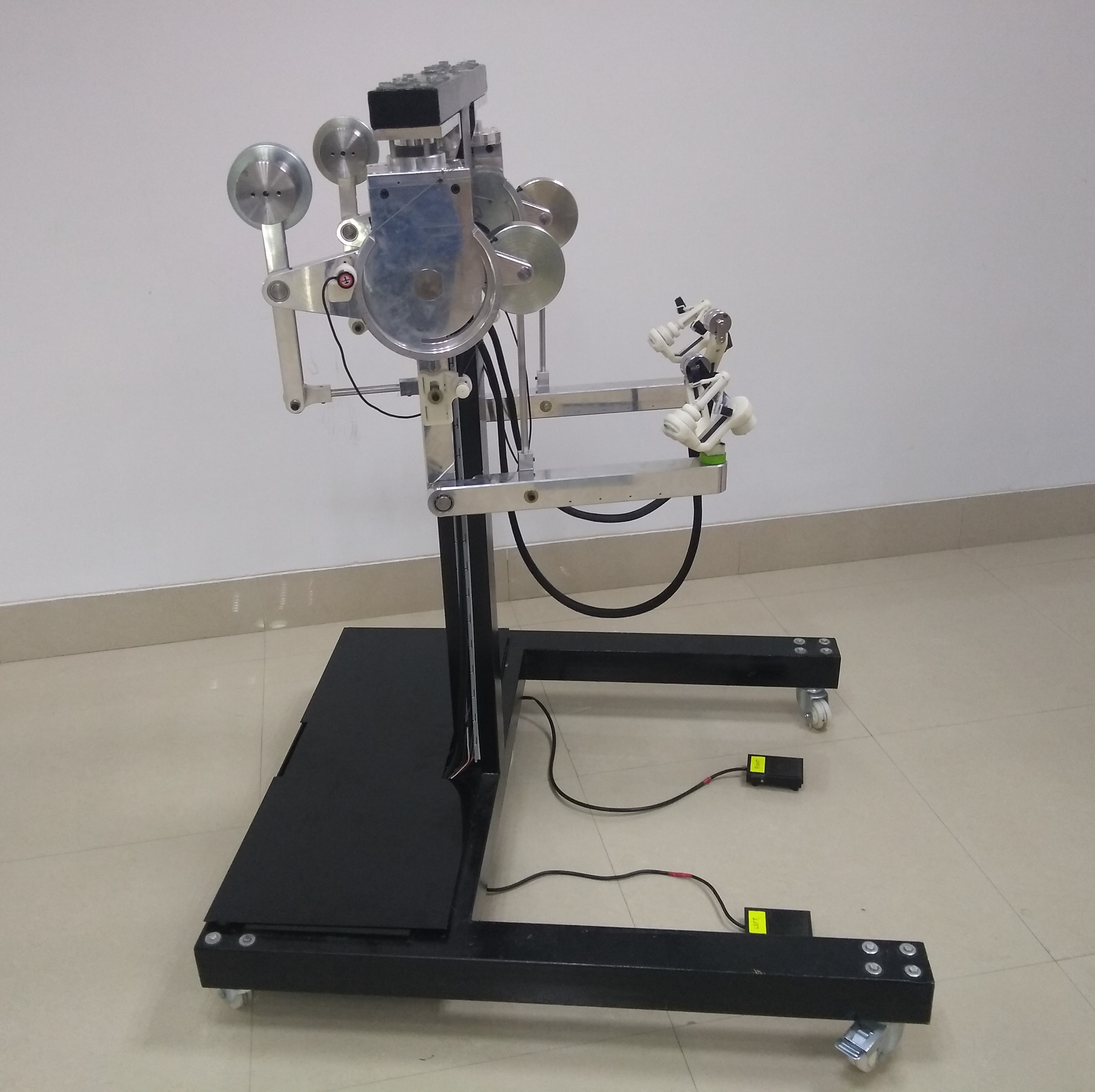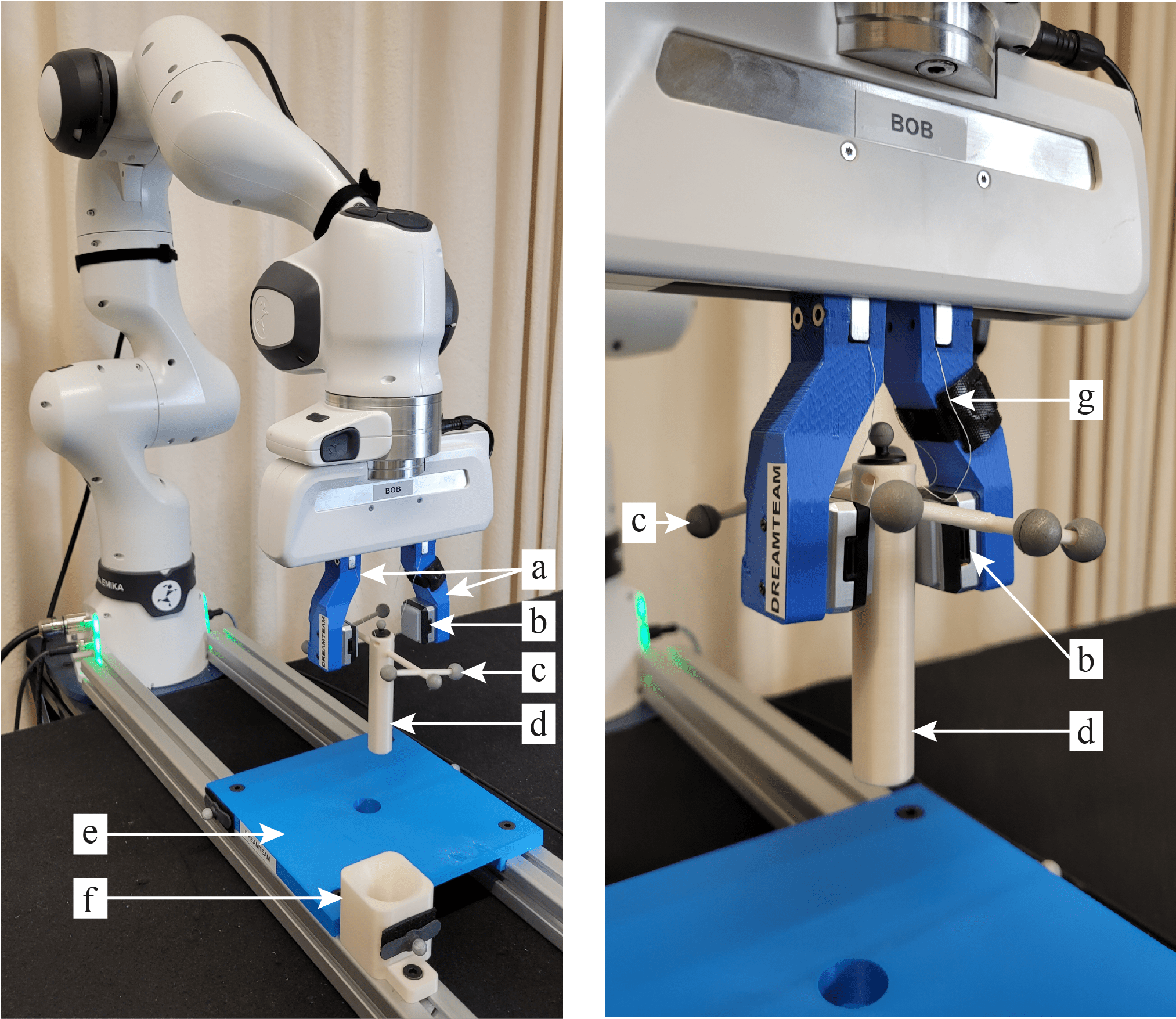Integrating Visuo-tactile Sensing with Haptic Feedback for Teleoperated Robot Manipulation
2404.19585

0
0
📈
Abstract
Telerobotics enables humans to overcome spatial constraints and allows them to physically interact with the environment in remote locations. However, the sensory feedback provided by the system to the operator is often purely visual, limiting the operator's dexterity in manipulation tasks. In this work, we address this issue by equipping the robot's end-effector with high-resolution visuotactile GelSight sensors. Using low-cost MANUS-Gloves, we provide the operator with haptic feedback about forces acting at the points of contact in the form of vibration signals. We propose two different methods for estimating these forces; one based on estimating the movement of markers on the sensor surface and one deep-learning approach. Additionally, we integrate our system into a virtual-reality teleoperation pipeline in which a human operator controls both arms of a Tiago robot while receiving visual and haptic feedback. We believe that integrating haptic feedback is a crucial step for dexterous manipulation in teleoperated robotic systems.
Create account to get full access
Overview
- Telerobotics allows humans to interact with remote environments, but the sensory feedback is often limited to visual information.
- This paper addresses this issue by equipping a robot's end-effector with high-resolution visuotactile GelSight sensors and providing the operator with haptic feedback through vibration signals using low-cost MANUS-Gloves.
- Two methods are proposed for estimating the forces acting on the sensor surface: one based on marker movement and one using a deep learning approach.
- The system is integrated into a virtual reality teleoperation pipeline, where a human operator controls a Tiago robot's arms while receiving visual and haptic feedback.
Plain English Explanation
Telerobotics is a technology that allows humans to control robots in remote locations, overcoming the constraints of physical distance. However, the feedback provided to the operator is often limited to visual information, which can make it challenging to perform precise manipulation tasks.
This research aims to address this issue by equipping the robot's end-effector (the part that interacts with the environment) with special sensors that can detect not only visual but also tactile information. These sensors, called GelSight sensors, can measure the forces acting on the robot's end-effector during interaction with the environment.
To provide the human operator with this tactile feedback, the researchers use a pair of low-cost MANUS-Gloves that can generate vibrations in the operator's hands, corresponding to the forces detected by the robot's end-effector. This allows the operator to "feel" what the robot is experiencing, which can greatly improve their dexterity and control during manipulation tasks.
The researchers propose two different methods for estimating the forces acting on the sensor surface: one based on tracking the movement of markers on the sensor surface, and the other using a deep learning approach. They then integrate this haptic feedback system into a virtual reality teleoperation pipeline, where a human operator can control a Tiago robot's arms while receiving both visual and tactile feedback.
By providing this additional haptic feedback, the researchers believe they can significantly improve the operator's ability to perform precise and dexterous manipulation tasks in remote environments using telerobotics.
Technical Explanation
The paper presents a teleoperation system that integrates high-resolution visuotactile GelSight sensors into the robot's end-effector to provide the human operator with haptic feedback in addition to visual feedback.
The researchers use low-cost MANUS-Gloves to deliver vibration signals to the operator's hands, corresponding to the forces detected by the GelSight sensors at the points of contact. Two methods are proposed for estimating these forces: one based on tracking the movement of markers on the sensor surface, and the other using a deep learning approach.
The teleoperation system is integrated into a virtual reality pipeline, where a human operator controls the arms of a Tiago robot while receiving both visual and haptic feedback. This allows the operator to experience a more realistic and immersive interaction with the remote environment, which the researchers believe is crucial for dexterous manipulation tasks in telerobotics.
Critical Analysis
The paper presents a promising approach to improving the dexterity and control of teleoperated robotic systems by providing haptic feedback to the human operator. The use of GelSight sensors and MANUS-Gloves to deliver vibration signals is a well-reasoned and practical solution to the limitations of purely visual feedback.
However, the paper does not address the potential limitations or challenges of this approach, such as the impact of latency in the feedback loop, the scalability of the system to more complex robotic platforms, or the long-term durability and reliability of the haptic feedback components.
Additionally, the paper does not provide a comprehensive evaluation of the system's performance, particularly in terms of the operator's task completion times, accuracy, and overall sense of immersion and embodiment. Further research and user studies would be needed to fully validate the benefits of this approach and identify any potential areas for improvement.
Conclusion
This research presents an important step forward in enhancing the capabilities of telerobotics systems by integrating haptic feedback into the operator's control loop. By providing the human user with a more realistic and immersive experience of the remote environment, the proposed system has the potential to significantly improve dexterity and precision in manipulation tasks performed through teleoperation.
While the paper does not address all of the potential challenges and limitations of this approach, it demonstrates the value of combining multiple sensory modalities to create more natural and intuitive human-robot interactions in telerobotics. Further development and evaluation of this technology could lead to advancements in a wide range of applications, from remote surgical procedures to search and rescue operations.
This summary was produced with help from an AI and may contain inaccuracies - check out the links to read the original source documents!
Related Papers

Advancing Robotic Surgery: Affordable Kinesthetic and Tactile Feedback Solutions for Endotrainers
Bharath Rajiv Nair, Aravinthkumar T., B. Vinod

0
0
The proliferation of robot-assisted minimally invasive surgery highlights the need for advanced training tools such as cost-effective robotic endotrainers. Current surgical robots often lack haptic feedback, which is crucial for providing surgeons with a real-time sense of touch. This absence can impact the surgeon's ability to perform delicate operations effectively. To enhance surgical training and address this deficiency, we have integrated a cost-effective haptic feedback system into a robotic endotrainer. This system incorporates both kinesthetic (force) and tactile feedback, improving the fidelity of surgical simulations and enabling more precise control during operations. Our system incorporates an innovative, cost-effective Force/Torque sensor utilizing optoelectronic technology, specifically designed to accurately detect forces and moments exerted on surgical tools with a 95% accuracy, providing essential kinesthetic feedback. Additionally, we implemented a tactile feedback mechanism that informs the surgeon of the gripping forces between the tool's tip and the tissue. This dual feedback system enhances the fidelity of training simulations and the execution of robotic surgeries, promoting broader adoption and safer practices.
6/27/2024

Safe haptic teleoperations of admittance controlled robots with virtualization of the force feedback
Lorenzo Pagliara, Enrico Ferrentino, Andrea Chiacchio, Giovanni Russo

0
0
Haptic teleoperations play a key role in extending human capabilities to perform complex tasks remotely, employing a robotic system. The impact of haptics is far-reaching and can improve the sensory awareness and motor accuracy of the operator. In this context, a key challenge is attaining a natural, stable and safe haptic human-robot interaction. Achieving these conflicting requirements is particularly crucial for complex procedures, e.g. medical ones. To address this challenge, in this work we develop a novel haptic bilateral teleoperation system (HBTS), featuring a virtualized force feedback, based on the motion error generated by an admittance controlled robot. This approach allows decoupling the force rendering system from the control of the interaction: the rendered force is assigned with the desired dynamics, while the admittance control parameters are separately tuned to maximize interaction performance. Furthermore, recognizing the necessity to limit the forces exerted by the robot on the environment, to ensure a safe interaction, we embed a saturation strategy of the motion references provided by the haptic device to admittance control. We validate the different aspects of the proposed HBTS, through a teleoperated blackboard writing experiment, against two other architectures. The results indicate that the proposed HBTS improves the naturalness of teleoperation, as well as safety and accuracy of the interaction.
4/12/2024

Human-Robot Interface for Teleoperated Robotized Planetary Sample Collection and Assembly
Lorenzo Pagliara, Vincenzo Petrone, Enrico Ferrentino, Pasquale Chiacchio

0
0
As human space exploration evolves toward longer voyages farther from our home planet, in-situ resource utilization (ISRU) becomes increasingly important. Haptic teleoperations are one of the technologies by which such activities can be carried out remotely by humans, whose expertise is still necessary for complex activities. In order to perform precision tasks with effectiveness, the operator must experience ease of use and accuracy. The same features are demanded to reduce the complexity of the training procedures and the associated learning time for operators without a specific background in robotic teleoperations. Haptic teleoperation systems, that allow for a natural feeling of forces, need to cope with the trade-off between accurate movements and workspace extension. Clearly, both of them are required for typical ISRU tasks. In this work, we develop a new concept of operations and suitable human-robot interfaces to achieve sample collection and assembly with ease of use and accuracy. In the proposed operational concept, the teleoperation space is extended by executing automated trajectories, offline planned at the control station. In three different experimental scenarios, we validate the end-to-end system involving the control station and the robotic asset, by assessing the contribution of haptics to mission success, the system robustness to consistent delays, and the ease of training new operators.
6/14/2024

Learning Tactile Insertion in the Real World
Daniel Palenicek, Theo Gruner, Tim Schneider, Alina Bohm, Janis Lenz, Inga Pfenning, Eric Kramer, Jan Peters

0
0
Humans have exceptional tactile sensing capabilities, which they can leverage to solve challenging, partially observable tasks that cannot be solved from visual observation alone. Research in tactile sensing attempts to unlock this new input modality for robots. Lately, these sensors have become cheaper and, thus, widely available. At the same time, the question of how to integrate them into control loops is still an active area of research, with central challenges being partial observability and the contact-rich nature of manipulation tasks. In this study, we propose to use Reinforcement Learning to learn an end-to-end policy, mapping directly from tactile sensor readings to actions. Specifically, we use Dreamer-v3 on a challenging, partially observable robotic insertion task with a Franka Research 3, both in simulation and on a real system. For the real setup, we built a robotic platform capable of resetting itself fully autonomously, allowing for extensive training runs without human supervision. Our preliminary results indicate that Dreamer is capable of utilizing tactile inputs to solve robotic manipulation tasks in simulation and reality. Furthermore, we find that providing the robot with tactile feedback generally improves task performance, though, in our setup, we do not yet include other sensing modalities. In the future, we plan to utilize our platform to evaluate a wide range of other Reinforcement Learning algorithms on tactile tasks.
5/2/2024